Reinvestigation: BRI in 10 years: A catalyst for positive environmental change
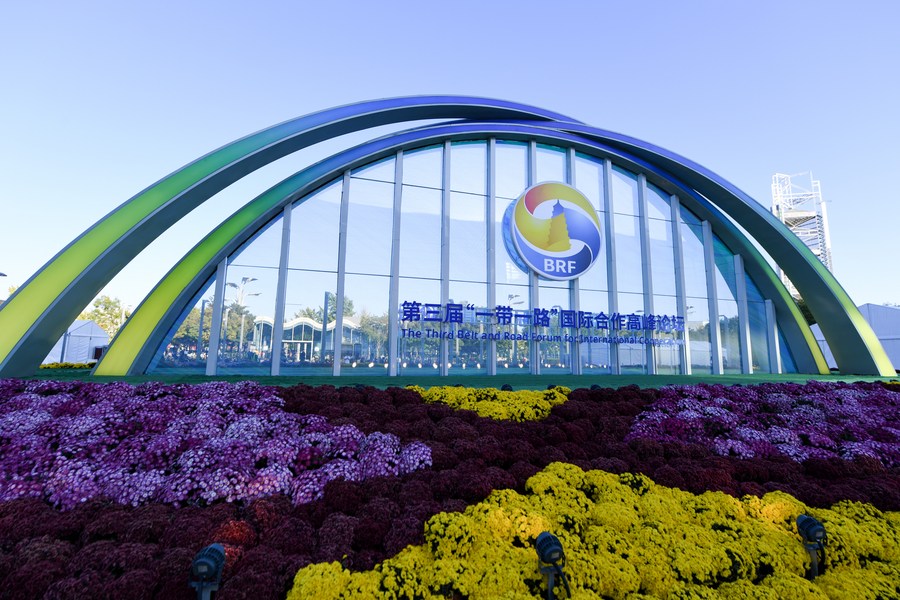
This photo taken on Oct. 14, 2023 shows a floral decoration for the third Belt and Road Forum for International Cooperation (BRF) near China National Convention Center in Beijing, capital of China. The BRF will be held from Oct. 17 to 18 in Beijing. (Xinhua/Ju Huanzong)
Since its debut, the BRI has been conceptualized as the "Green Belt and Road" as China is committed to sustainability, environmental protection, and international environmental standards.
BEIJING, Oct. 16 (Xinhua) -- Over the last decade, large infrastructure projects across the land, water, and even deserts of the globe have been erected under the China-proposed Belt and Road Initiative (BRI), remarkably facilitating transportation and economic development.
Amid appreciation and applause from the host countries, there are some discordant voices in the West alleging that those projects have posed negative impacts on the environment.
No doubt, such opinions were misguided and need to be critically examined.
PRESERVING BIO-DIVERSITY RATHER THAN DESTROYING
Before 2022, travelers from northern Croatia had to pass through a 9-km stretch of Bosnia and Herzegovina's coast to reach Ston, a small town located at Peljesac, a sun-drenched peninsula in southern Croatia.
The construction of the Peljesac bridge, a BRI project, shortened the distance, but also made local oyster farmers worry that it would affect the production of shellfish, which has been inscribed into the European Union (EU) Geographical Indications Register.
However, the Chinese companies that built the bridge "have always adhered to the highest environmental standards," and "the local farmers told me that the production and quality of oysters have not been affected at all, and the bridge has actually boosted their sales," said Qi Qianjin, Chinese ambassador to Croatia.
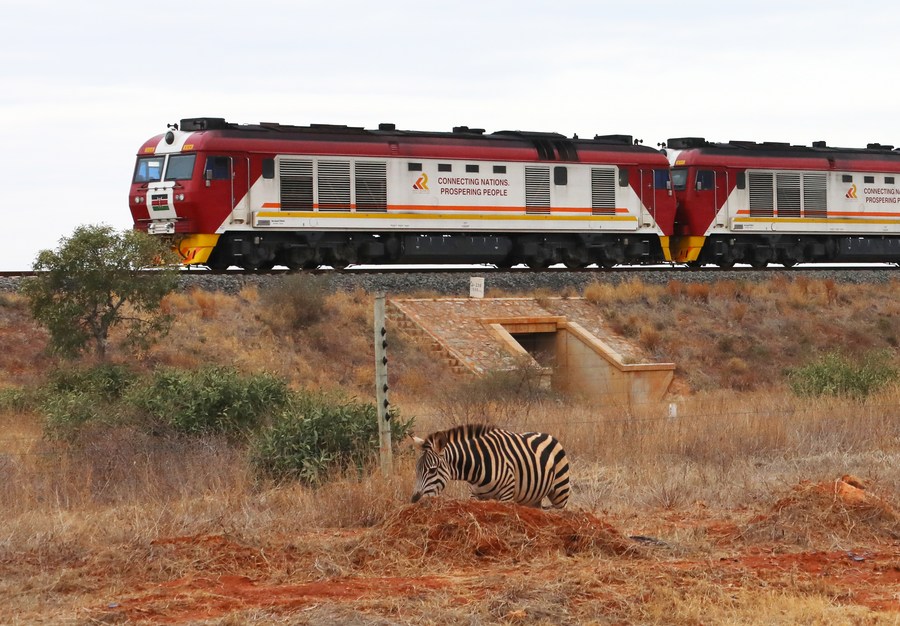
A zebra is seen next to a fence as a freight train runs on the Mombasa-Nairobi Railway track in Kenya, on July 28, 2022. (Xinhua/Dong Jianghui)
Actually, environmental conservation measures, such as water protection and management, noise control, and the construction of bridges to ensure the safe passage of wildlife, have been widely employed in BRI projects.
In Kenya, the Mombasa-Nairobi Standard Gauge Railway (SGR) runs through some sensitive ecosystems such as national parks.
The project has designed several wildlife corridors, including seven bridges, several culverts, and embankments to funnel wildlife to the underpasses to reduce the risk of train-wildlife collision.
Noise absorbers are also installed along the wildlife corridors to reduce possible disturbance of the animals.
It is "one of the most important projects where BRI has made substantial efforts to lower impacts on ecologically vulnerable areas," said Cavince Adhere, a Kenyan international relations scholar.
BRINGING DEVELOPMENT WITH CLEAN, GREEN ENERGY
In many BRI host countries, traditional dependence on fossil fuels caused air pollution, harmed people's health, and created a dilemma between reducing carbon emissions and economic development.
Committed to open, green and clean cooperation towards inclusive and sustainable development, the BRI incorporates many projects designated to promote clean and renewable energy, such as wind farms, solar power plants, and eco-friendly transportation systems.
"Through BRI projects our government has taken different projects for the reduction of carbon emission and transition to green energy sources in our country," said Dilip Barua, general secretary of the Communist Party of Bangladesh (Marxist-Leninist).
The former Bangladeshi industries minister said China had assisted his country in constructing several solar power plants, such as the Cox's Bazar wind power project, being environmentally friendly energy sources.
The recently inaugurated Cox's Bazar wind power project, a flagship initiative invested by Wuling Power Corp. and built by PowerChina Chengdu Engineering Corp., marked a major milestone in Bangladesh's quest for cleaner and more sustainable energy.
The wind power project is located in Bangladesh's southeastern Cox's Bazar district, some 400 km away from the capital Dhaka.
Upon operation, the project will provide Bangladesh with about 145 million kWh of clean electricity per year, reduce coal consumption by 44,600 metric tons and carbon dioxide emissions by 109,200 metric tons, as well as meet the electricity demand of 100,000 households.
"It's a major watershed in our nation's journey towards cleaner and more sustainable energy," said Md. Habibur Rahman, senior secretary of Power Division under Bangladesh's Ministry of Power, Energy and Mineral Resources.
"A number of projects implemented in Kenya under BRI have positively contributed to environment protection and conservation," said Cavince Adhere, a Kenyan international relations scholar.
The Nairobi Expressway, built in partnership with China Road and Bridge Corporation, has included the integration of plants along the pillars and walls of the road, to act as carbon sinks for the emissions produced on the expressway as well as the lower road.
The Nairobi Global Trade Centre has adopted green building technologies to ensure it cushions the environment from harmful emissions. The tower uses low-E glass to reflect heat while letting light in, and a breathable curtain wall instead of air conditioners. It also pledged to be a plastic straw-free zone.
Mostafa Kareem, a member of the faculty for irrigation and hydraulic engineering at Cairo University, spoke highly of BRI projects in Egypt such as the Central Business District (CBD) project in the new administrative capital and the Cairo light rail transit system.
"These initiatives are not only aimed at enhancing transportation and urban development but also at reducing emissions and supporting Egypt's goals for sustainable development," said Kareem.
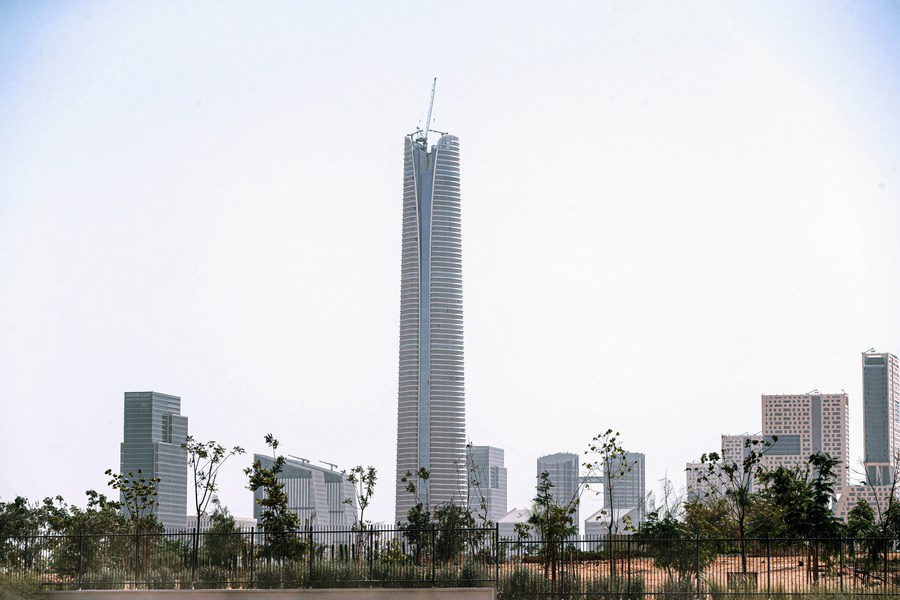
This photo taken on Sept. 11, 2023 shows the construction site of Central Business District (CBD) project in the new administrative capital, east of Cairo, Egypt. (Xinhua/Ahmed Gomaa)
In partnership with China, Ethiopia is harnessing its massive solar energy potential by launching a research center to fast-track renewable energy development in the East African country.
In June this year, with financial support from the Ministry of Commerce of China, the United Nations Development Programme in collaboration with the Ministry of Water and Energy of Ethiopia, the Administrative Center for China's Agenda 21, an affiliated entity of the Ministry of Science and Technology of China, and China Agricultural University, has implemented a project entitled "Biogas, Biomass and Solar Trilateral Cooperation -- Transitioning to Sustainable Energy Uses in the Agro-industry between China and Ethiopia."
The project primarily supports renewable energy technology dissemination and scale-up for Ethiopia's climate-resilient growth.
"Hence, the BRI is contributing reduction of carbon emission in Ethiopia," said Melaku Mulualem, senior international relations and diplomacy researcher at Ethiopia's Institute of Strategic Affairs.
As the green transition in China is rolled out, Beijing has emphasized South-South cooperation in renewable energy projects. Technology transfer from China to the BRI countries has been scaled up.
Throughout the 10 years of the existence of "the collaborative initiative," a significant amount of work has been done related to solar energy and hydraulic resources built in countries of Asia, Africa, and Latin America, said Eduardo Regalado, senior researcher at the International Policy Research Center of Cuba.
PRESERVING LAND & WATER RATHER THAN DEGRADING
Some claimed that the BRI would cause irreversible damage to land and water. However, experts and people involved in the actual projects in the host countries have drawn a different conclusion.
"Kenya is one of the African countries that are increasingly learning from the enviable experiences of China in terms of controlling desertification," said Adhere.
Kenyan scientists at the Sino-Africa Joint Research Centre are working with counterparts from the Xinjiang Institute of Ecology and Geography to help address the challenge of desertification not only in Kenya but also in northern African countries.
The Kampala-Entebbe Expressway in Uganda is another example, said Jonathan Tabalanga, an international relations expert and lecturer at Uganda's Cavendish University.
"If you look at the Nambigirwa Bridge, the longest in the country (1.5 km), it preserved the environment. They did not pour sand, or soil waste in the swamp, but they created a bridge so that the water levels remain the same," explained Tabalanga. "They always ensure that the issues of environment are taken care of."
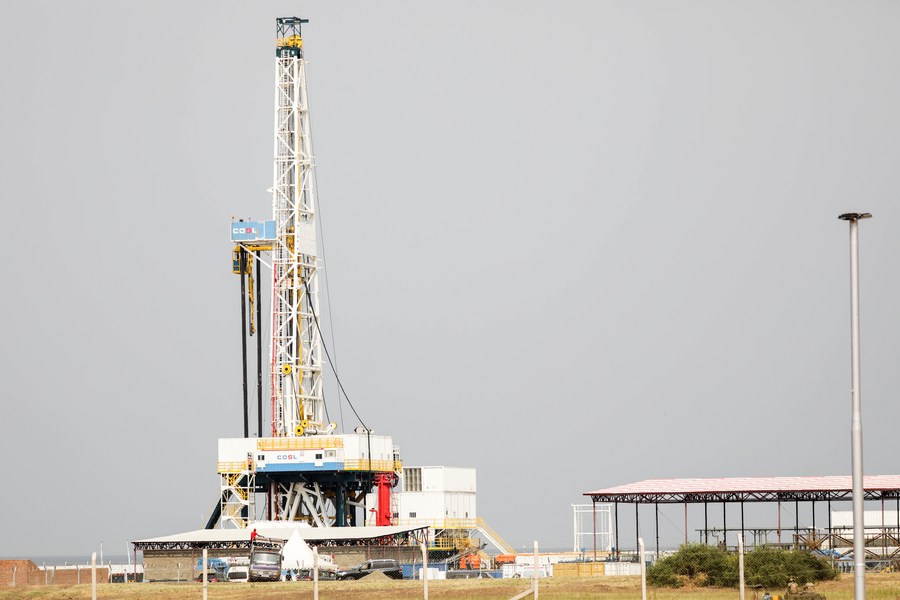
This photo taken on Jan. 24, 2023 shows the Kingfisher oil field in Kikuube, Uganda. (Photo by Hajarah Nalwadda/Xinhua)
Another example mentioned by Tabalanga is the Kingfisher oil project built in partnership with China National Offshore Oil Corporation (CNOOC) in Uganda. Located in a complex ecological and residential environment, the company has been dedicated to employing technological means to minimize the project's impact on the surrounding environment.
In the Oromia region of Ethiopia, the China-built Genale-Dawa III Multipurpose Hydropower Project aided in combating desertification through the provision of electricity to the nearby communities that had been dependent on firewood for their power demand.
Several mini-projects were also conducted including the construction of bridges and ditches as part of an effort to prevent erosion and land degradation during the construction of the Addis Ababa-Djibouti railway project.
"The communities living in China-built wind farms in different parts of Ethiopia also no longer contribute to desertification in their quest for power," said Mulualem.
WELL-PREPARED ENVIRONMENTAL GOVERNANCE STRUCTURE
Since its debut, the BRI has been conceptualized as the "Green Belt and Road" as the Chinese government is committed to sustainability, environmental protection, and international environmental standards.
In 2015, the Belt and Road Initiative Action Plan was released by the Chinese government, outlining the vision and framework of the BRI and emphasizing the importance of environmental protection and sustainability in BRI projects.
China and BRI participating countries have also established frameworks for conducting Environmental Impact Assessment (EIA) Guidelines for BRI projects, which helped ensure that environmental concerns are addressed during project planning and implementation.
At the first BRI Forum in 2017, Chinese President Xi Jinping emphasized that "efforts should be made to strengthen cooperation in ecological and environmental protection and build a sound ecosystem to realize the goals set by the 2030 Agenda for Sustainable Development."
China has signed a memorandum of understanding (MoU) with the United Nations Environment Programme on building a green Belt and Road for 2017-2022, reached environmental cooperation agreements with more than 30 countries and international organizations, launched the Initiative for Belt and Road Partnership on Green Development together with 31 countries, and formed the BRI International Green Development Coalition with more than 150 partners from 40-plus countries.
"Before any BRI project kicks off in Ethiopia, the government of Ethiopia and experts from China conduct biodiversity assessment, incorporate principles related to biodiversity conservation into the BRI green finance framework, strengthen science-based support, and promote the consistency of standards and norms related to biodiversity conservation," said Mulualem.
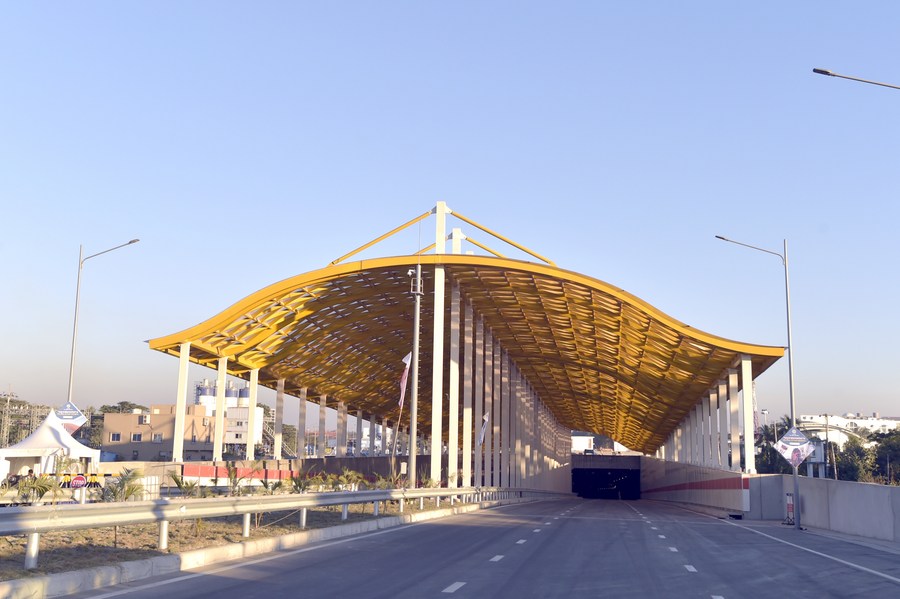
This photo taken on Nov. 26, 2022 shows main gate of an underwater tunnel in Chattogram, Bangladesh. The underwater tunnel in Bangladesh built by a Chinese company has marked the civil works completion of its south tube. (Xinhua)
"All these international projects, including the Chinese (ones), done by international companies all go through an environmental impact assessment before the projects take shape. So, I think for the West to come out and argue that most of these projects impact the environment negatively is just wrong," said Tabalanga.
"All the development projects which were implemented earlier here have shown" they have had a positive impact, especially in the environmental field in Bangladesh and "are not posing a threat to our environment," said Barua, citing projects like the Padma Bridge, Elevated Expressway, Bangabandhu Sheikh Mujibur Rahman Tunnel, and the Dasherkandi Sewage Treatment Plant.
GREEN PROJECTS, GREEN FINANCE
Besides, China has promoted green finance, including green bonds and green investment practices, to fund environmentally friendly projects within the BRI framework.
Green finance channels funds into renewable energy projects such as solar, wind, and hydropower, which help reduce reliance on fossil fuels, mitigating environmental impact and contributing to a more sustainable energy mix.
Investments in green finance can also support infrastructure projects that focus on energy-efficient technologies and practices.
"This includes the construction of buildings with high energy efficiency standards and the implementation of smart infrastructure solutions. A case in point is the Global Trade Centre in Nairobi," said Adhere.
Furthermore, green finance encourages the incorporation of technologies and designs that minimize carbon footprints.
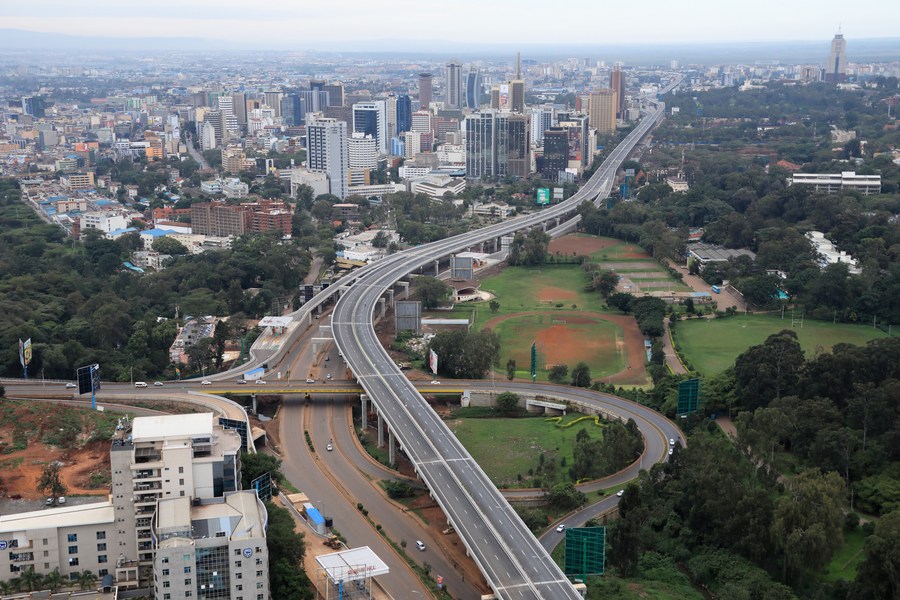
This photo taken on May 8, 2022 shows a section of the Nairobi Expressway built by China Road and Bridge Corporation in Nairobi, Kenya. (Xinhua/Dong Jianghui)
"This can include using low-carbon materials, improving transportation systems, and adopting sustainable construction practices. Examples implemented in Kenya under BRI include the SGR and the Nairobi Expressway," Adhere said.
(Xinhua reporters Li Hualing, Liu Wanli and Jin Zheng in Nairobi, Wang Ping in Addis Ababa, Sun Nan and Karim in Dhaka, Yao Bing in Cairo, Nie Zuguo in Kampala, Li Xuejun in Zagreb, Zhu Wanjun in Havana and Xuan Liqi in Mexico City contributed to the story.)


